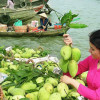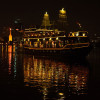Ho Chi Minh City General Introduction
- Area: 2,095.2 sq. km
- Population: 7.990,1 millions of people (2013)
- Administrative divisions: Districts of 1, 2, 3, 4, 5, 6, 7, 8, 9, 10, 11, 12, Tan Binh, Binh Thanh, Phu Nhuan, Thu Duc, Go Vap, Binh Tan and Tan Phu and Rural Districts of Nha Be, Can Gio, Hoc Mon, Cu Chi and Binh Chanh
- Ethnic minority groups: Viet (Kinh), Hoa, Khmer, Cham …
Geography
Lying entirely in the core of the Mekong Delta Region, Ho Chi Minh City (formerly called Saigon) is the 2nd most important one in Vietnam after the administrative capital of Hanoi. For many years, it has been considered not only as a commerce center but a scientific, technological, industrial and tourist center as well.
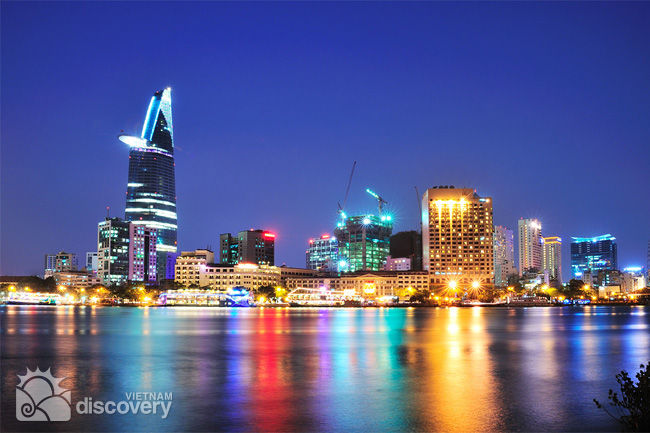
Ho Chi Minh City sparkling at night (view from Saigon River)
Additionally, there are lots of rivers, arroyos and canals inside and outside Ho Chi Minh City, of which the biggest is the Saigon River.
Climate
Generally speaking, the climate of Ho Chi Minh City is hot and humid. Different from the Northern regions in Vietnam, Ho Chi Minh City possesses two distinctive seasons, including the rainy season, which lasts from May to November, and the dry season from December to April. It is warm all year around with the average temperature of 27 Degree Celsius. April is the hottest month; on the other hand, the lowest is December.
Ho Chi Minh City is best to visit in the dry season because tropical storms frequently appear during the wet season. If you plan to visit this Southern city, you should pay attention to its climate and weather before starting your trip in Ho Chi Minh City.
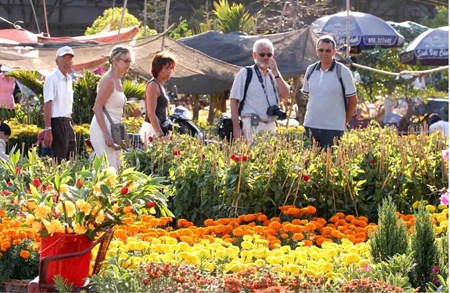
Best time to visit Ho Chi Minh City is in dry season, especially during Vietnamese traditional Tet Festival
Tourism
Presently, Ho Chi Minh City is the Vietnam’s big tourism center, which attracts a huge number of visitors to Vietnam every year. There are numerous attractions in Ho Chi Minh City such as Ho Chi Minh Museum (formerly known as Dragon House Wharf), Cu Chi Tunnels and a wide system of museums, theatres and cultural houses … Up to now, many must-see tourist attractions have been invested like Thanh Da Island, Binh Quoi Village, Dam Sen Park, Saigon Water Park, Suoi Tien, Ky Hoa, etc.
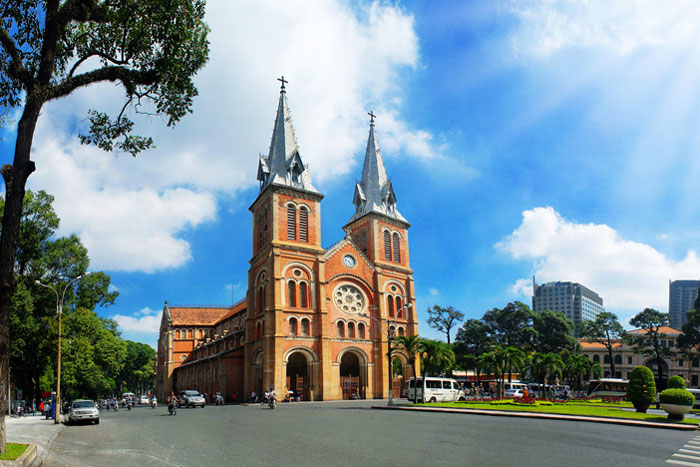
Notre Dame Cathedral, one of the Ho Chi Minh City’s attractions
Furthermore, Ho Chi Minh City Despite has various architectural and beautiful buildings which display a great cultural combination of Vietnam, China and Europe. They can be named as Ben Nha Rong (Dragon House Wharf), Quoc To Temple (National Ancestors Temple), Xa Tay (Municipal Office), Ho Chi Minh Municipal Theatre and wide range of pagodas and churches of Vinh Nghiem, Giac Vien, Giac Lam, Phung Son … For more than 300 years of development, Ho Chi Minh City has been attracted visitors for its ancient architectural constructions, famous vestiges and renowned sights as well as its harmonious blending of traditional national values with northern and western cultural features.
Transportation
Ho Chi Minh City is conveniently reached as it is the main junction for trains, roads, water, and air transportation systems for local Vietnam trips and for Indo-china destination.
- Via route: Ho Chi Minh City is 1,730km from Hanoi, 99km from Tay Ninh, 30km from Bien Hoa (Dong Nai), 70km from My Tho, 125km from Vung Tau, 168km from Can Tho, 308km from Dalat, and 375km from Buon Ma Thuot. The City has National Highway 13 which connects Vietnam with the rest of Indochina.
- Via railway: The Thong Nhat Express Train linking between Ho Chi Minh City and Hanoi passes through many provinces in Vietnam.
- Via airlines: The biggest international airport of Tan Son Nhat is only 7km far from the Saigon downtown. Flights from Hanoi and Danang to Ho Chi Minh City and from the City to many regions in Vietnam and lot of countries all over the world are available every day.



